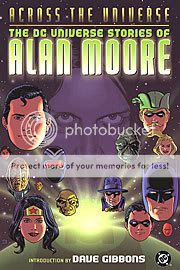Across the Universe: The DC Universe Stories of Alan Moore
Alan Moore, writer
Dave Gibbons, Klaus Janson, Jim Baikie, Kevin O’Neill, Paris Cullins, Rick Veitch, Al Williamson, Joe Orlando, Bill Willingham, George Freeman, artists
DC Comics, 2003
208 pages
$19.95
Though it’s now out of print, having been supplanted by a collection that also includes the longer stories Batman: The Killing Joke and Superman: Whatever Happened to the Man of Tomorrow?, this particular anthology of mainline-DC stories by Alan Moore is the superior book, and not just because of the absence of the irksome reproduction errors that plagued the two aforementioned stories in the later edition. Without those two tales–both of them swinging-for-the-fences “last word” efforts about their respective milieus, grim’n’gritty Batman and Silver Age Superman–overshadowing the proceedings, we’re able to better compare in apples-to-apples fashion the short stories that remain, and better appreciate their pleasurable successes–and almost as pleasurable failures.
Moore’s superhero work dealt with the same problems as any superhero story–devising wild science-fiction settings, creating threats believable enough to overwhelm the audience’s knowledge that nothing bad is really gonna happen to our hero, deriving resonance from each character’s time-honored tropes. The best I can do to describe what he did differently from his contemporaries is to say that he solved these problems by attacking them from a completely different direction than any other writer at the time.
For example, in not one but two separate “Superman vs. parasitical plant life” stories–the Swamp Thing crossover “The Jungle Line” and the now-classic be-careful-what-you-wish-for tale “For the Man Who Has Everything”–Moore makes the all but invulnerable Superman eminently vulnerable, physically and emotionally, by tying him back to his roots in the apocalyptic extermination of Krypton and its inhabitants. Rather than simply throw another alien powerhouse or supergenius at the guy as most writers would do, Moore plays off the “Last Son” aspect of the character to create a threat that’s primarily emotional rather than physical or mental–blazing a path that’s still followed by the character’s most successful interpreters to this day.
Many of his other novel approaches stem from the classical science-fiction notion of a “literature of ideas,” as opposed to the superhero science-fiction norm of humanoid aliens in crazy clothes with laser guns. These stories’ strength is one of raw concept: How would a Green Lantern power ring operate for a being with no concept of light or sight? How do you conquer beings who operate on a time frame so slow that it would take them years to even notice your presence? How do you teach the birds and the bees to a species with no females? Why limit the aliens we encounter to more or less humanoid forms when they could be sentient planets or sentient smallpox viruses? It’s a litany of the kind of idea that’d blow the minds of anyone whose idea of science fiction began on Tattooine and ended on Krypton.
The art in the collection firmly roots it to the time of its origin. To a superhero reader raised on the high-gloss, digitally colored, border-busting, photoref’d slugfests of today, it all must look hopelessly primitive; even the artists who still have some name-recognition juice today, like Dave “Watchmen” Gibbons and Klaus Janson, come across as quaintly classicist and nostalgically sloppy respectively. (God only knows what a Greg Land fan would make of the Lovecraftian avant-garde demons in Kevin O’Neill’s creepy Green Lantern story!) But this too plays to Moore’s strengths as a writer in this period by harkening back to a simpler time before the writer grew so fixated on form and referentiality, instead preferring simple superhero morality plays of idea and emotion.
Not everything works, not by a long shot. Stories involving street-level heroes Green Arrow & Black Canary and Vigilante are distinguished primarily by less-than-enthralling narrative conceits, the former likening a night in the big city to an athletic event for no clear reason and the latter interspersing Vigilante’s team-up with a comically clichéd party girl (“I’ve got forty kilos of good Colombian weed stashed up there!”) with excerpts from the creepily loving letter of the pedophile they’re chasing to his intended victim. A Batman story from the perspective of an obscure, insane villain who thinks he’s perfectly sane has its limitations revealed by the two decades’ worth of such stories that followed. All the standard pitfalls of ’80s superhero comics can be found at one point or another: multiracial vest-wearing street gangs, howlingly unrealistic dialect, incongruously forcing clunky sci-fi ideas into conversational speech (“Why are you still staring out of the window? The underlights of Aunt Allura’s paragondola vanished five units ago.”).
But those good stories—the Superman, Green Lantern, and Vega ones mostly—are really awfully good. Best of all they make it seem like telling a good story was Moore’s only goal. Maybe that’s why I enjoy this book as much as almost anything I’ve read by the bard of Northampton: With no Victoriana to riff on and no snake gods to worship, the guy can spin a heckuva yarn.
Tags: comics, comics reviews, Comics Time, reviews


Damn. This is good.
“Moore plays off the “Last Son” aspect of the character to create a threat that’s primarily emotional rather than physical or mental” = yep.
“But this too plays to Moore’s strengths as a writer in this period by harkening back to a simpler time before the writer grew so fixated on form and referentiality, instead preferring simple superhero morality plays of idea and emotion.” = yep.
“With no Victoriana to riff on and no snake gods to worship, the guy can spin a heckuva yarn.” = yep.
NIce one.